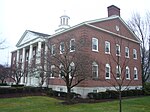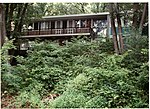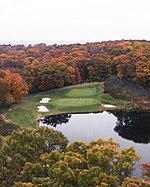Col. Asa Platt House
Federal architecture in ConnecticutHouses completed in 1810Houses on the National Register of Historic Places in ConnecticutNational Register of Historic Places in New Haven County, ConnecticutOrange, Connecticut

The Colonel Asa Platt House is a historic house at 2 Tyler City Road in Orange, Connecticut. Built about 1811, it is a high-quality example of Federal period architecture, which is likely the work of New Haven builder David Hoadley. It was listed on the National Register of Historic Places in 2002.
Excerpt from the Wikipedia article Col. Asa Platt House (License: CC BY-SA 3.0, Authors, Images).Col. Asa Platt House
Racebrook Road,
Geographical coordinates (GPS) Address Nearby Places Show on map
Geographical coordinates (GPS)
| Latitude | Longitude |
|---|---|
| N 41.286666666667 ° | E -73.011388888889 ° |
Address
Racebrook Road 589
06477
Connecticut, United States
Open on Google Maps






